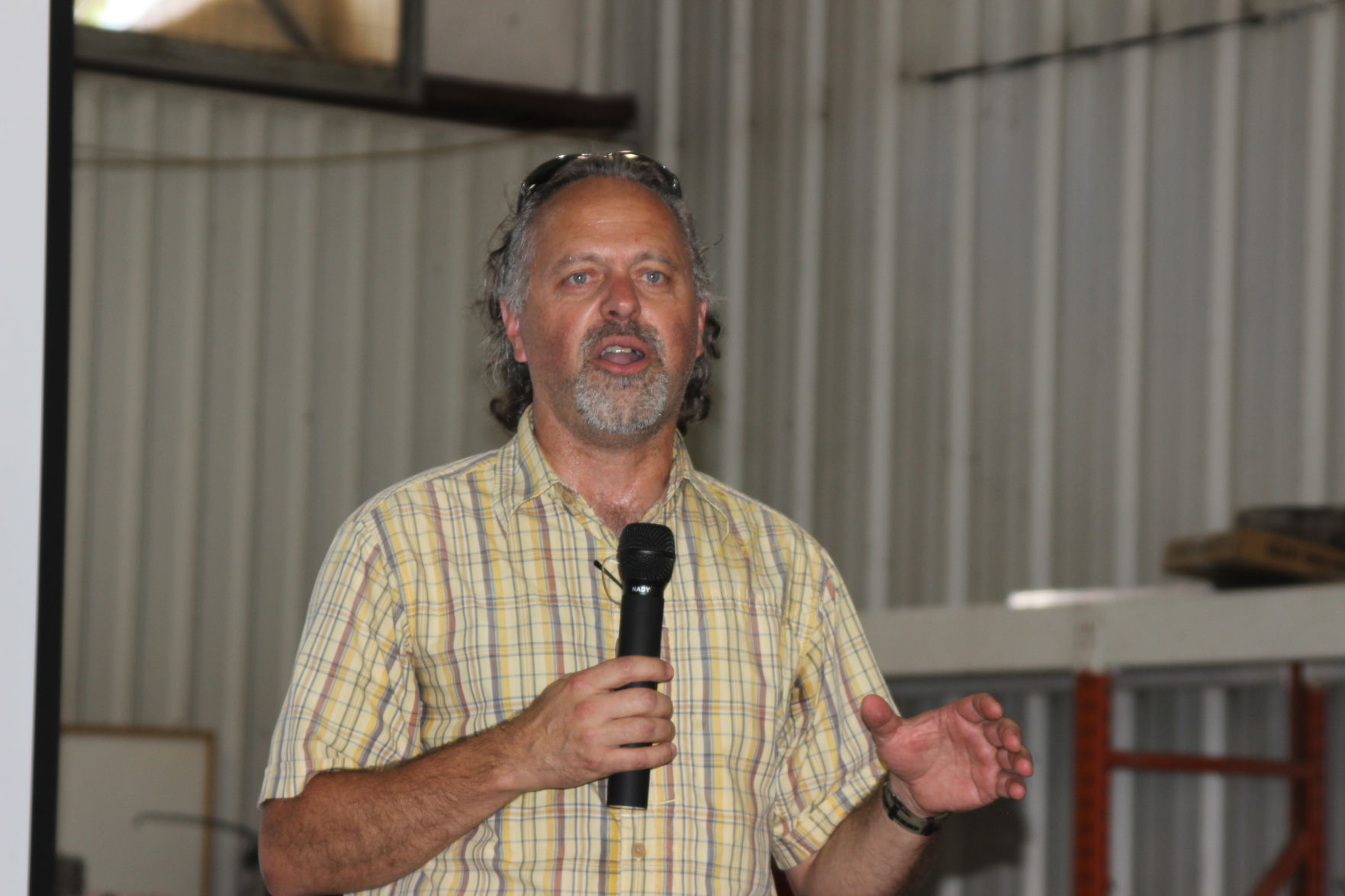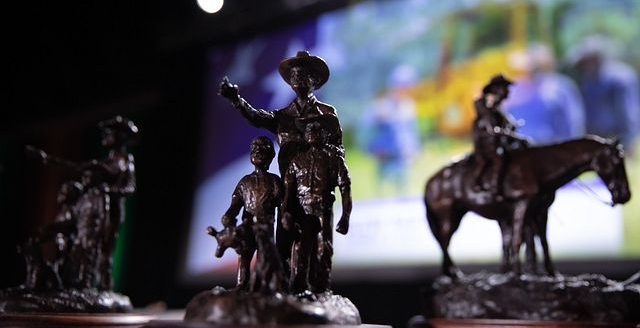The dairy industry continues to grow in western Kansas and the owners and managers of High Plains Ponderosa tout the synergy that starts with consumer demand, plus the availability of feed and labor and reasonable regulations are ingredients for success at the Plains operation.
Greg Bethard, general manager of High Plains Ponderosa Dairy and a Wisconsin native, said the farm is “a dream come true” because of the support the operation receives from neighbors, local businesses, schools, employees and the industry.
David Clawson, a Clark County farmer and rancher and co-owner of the operation, told about the growth of the dairy, which started in 2001.
High Plains Ponderosa Dairy is jointly owned by Kansas and Wisconsin families. The original dairy opened in October 2001 with the option to milk 2,100 cows. By 2015, it had grown to accommodate 4,500 head. Further expansion occurred and in 2018 the herd tripled with the addition of a rotary milking parlor and a cross-bent, free-stall housing barn that houses 9,500 head on 16 acres under one roof.
The Aug. 13 Ranch Management Field Day at Ormiston Farms also included timely updates on the cattle industry. A tour of the High Plains Ponderosa Dairy was all part of the program sponsored by the Kansas Livestock Association, K-State Research and Extension, Farm Credit Association of Kansas and Bayer.
“We cannot say enough about the people of Kansas who allow us to milk our cows,” Bethard said.
The dairy milks 14,000 head twice a day from an overall herd of about 26,000 cows. It has a 110-stall rotary parlor that is now the second biggest in the world and milks 860 cows per hour. Cows, with ease, climb into the rotary parlor, every 4 seconds.
“They like following the leader,” Bethard said. The cows ride the carousel for about 6 1/2 minutes. Normally, the entire milking process takes about 4 1/2 minutes. Once the ride is finished the cows leave the carousel and head to rest in sand-bedded free stalls with new bedding added each day.
“When they are done they are happy,” Bethard said.
Once the milk is collected it is cooled to 35 degrees Fahrenheit and loaded into insulated tankers and the liquid is taken to cheese, powder and bottling plants in Kansas, Texas and New Mexico. High Plains sells more than 100,000 gallons of milk a day to Dairy Farmers of America, the largest milk cooperative in the country.
“All milk is antibiotic free,” he said.
Cows are fed a mixed ration on a daily basis that includes corn silage, alfalfa haylage, wheat silage and sorghum silage, Clawson said. High Plains Ponderosa grows some of its own silage but the vast majority comes from local farmers. Commodities fed include cottonseed, soybean meal, corn gluten feed, distillers’ grains, canola meal and soy hulls. The dairy mixes and feeds more than 2 million pounds of mixed rations daily, Clawson said.
Each cow produces about 70 pounds of milk a day, Bethard said.
Bethard also took time to address consumer perception. Bethard says consumers enjoy the taste of milk products and recognize the products are healthy. The environmental stewardship is on display through the entire process and yet he recognizes his industry faces people who will go to great lengths to smear animal agriculture operations and unfortunately those who do so will not listen to reason.
As a result, the dairy does not have a web page or Facebook page. He told those on the tour that the dairy is limited to tours of guests who are friendly to animal agriculture. No pictures or videos are allowed around the operation.
Employees are strictly screened and they sign an animal welfare policy agreement that states any abuse of animals is not tolerated, Bethard said. The employee must not be an abuser and if he sees someone who appears to be abusing an animal they must immediately report the incident to a supervisor. Those who fail to follow the policy face immediate dismissal.
Timely updates
In her welcoming address, Barb Downey, Wamego, the president of the KLA, told tour-goers the dairy council is important to the livestock industry and has been innovators in High Plains agriculture. She also told all those affiliated with animal agriculture face unique pressures plus economic pressures.
Sign up for HPJ Insights
Our weekly newsletter delivers the latest news straight to your inbox including breaking news, our exclusive columns and much more.
“Our industry faces challenges from animal rights activists to international trade,” she said, adding unity is needed. “We are stronger together.”
Lee Reeve, a long-time southwest Kansas beef producer from Garden City, also shared information he had learned from the Aug. 9 Tyson plant fire in Holcomb. The fire came at a time of “pretty tight capacity” and the downward pressure on cattle prices hurt the industry.
“It was pretty devastating on the futures,” Reeve said, adding that some normalcy was starting to return. “The other packers will have to pick up the 6,000 head a day.”
He said thousands of carcasses were destroyed in the fire as he tried to paint a picture of the damage in the plant.
Tyson officials have been reassuring the local community and livestock industry they plan to get the plant operational as quickly as possible and that prices were starting to rebound. The commitment to pay employees during the shutdown was a positive sign.
“We’ll get through this,” Reeve said. “We’ve gotten through these tough times before.”
Watch for insects
A.J. Tarpoff, a Kansas State University assistant professor and Extension beef veterinarian, offered insight into fighting external parasites in beef cattle. He said horn flies account for up to $1 billion worth of losses and their impact through a decrease in average daily gain, milk production, feeding pattern and treatment and control costs.
Horn flies lay eggs in fresh manure and spend the majority of their life cycle on cattle. They rarely move from animal and their population rises in late May and persist into fall. The hightest numbers are on dark hided animals and bulls. Stable flies are another cattle irritant and they offer a painful bite to the legs of cattle. The adult flies spend their time off cattle. Any moist organic matter is prime location for eggs and larvae and he said prime breeding areas are in straw bedding, spilled feed, manure piles, round bale feeding sites, calf hutches, alleys and feeding areas.
Monitoring horn flies and stable flies and reducing their habitat is one way to reduce their breeding opportunities.
Face flies are also painful for cattle and hard to control because they spend so much time off the animal. He said forced exposure to an insecticide is best but like other flies require constant monitoring. He also advised producers that when they apply insecticides to consider rotating their type of applications to try to prevent chemical resistance. The same also applies for ear tags that release insecticides.
Ticks can also be a problem for cattle as well as humans and pets, he noted that tick populations are difficult to eradicate although controlling cedar tree populations can help.
Traceability update
Cassie Kniebel, CattleTrace program manager for the Beef Cattle Institute in Manhattan, Kansas, provided an update on a cattle traceability program intended to help guide the development of a cost-effective national traceability program. The program is a focus for the KLA, Kansas State University and the Kansas Department of Agriculture and is part of the overall biosecurity of the beef industry. People who have questions are encouraged to contact Kniebel by email at [email protected].
Dave Bergmeier can be reached at 620-227-1822 or [email protected].




